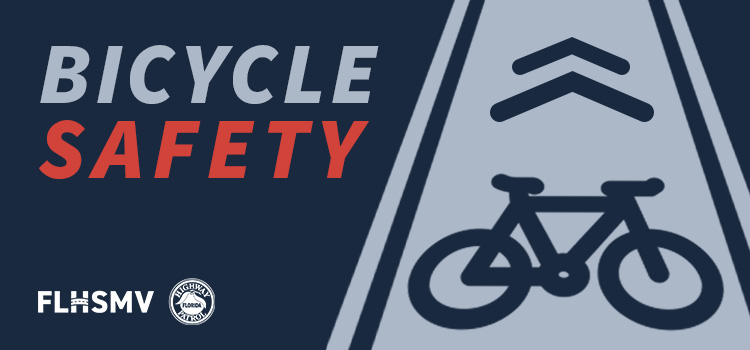Driving Safety
Bicycle Safety Awareness

According to Florida law, a bicycle is legally recognized as a vehicle, and the person who is riding the bike is considered to be a driver. As a result, individuals who ride bikes have the same rights on the roadways as other vehicle operators and must abide by the same traffic laws.
These laws include stopping at stop signs and red lights, riding with the flow of traffic, using lights when riding at night, giving way to other drivers when entering a roadway, and yielding to pedestrians in a crosswalk.
Rules for Bicyclists
- A bicyclist must obey all traffic controls and signals.
- A bicycle may only be used to carry the number of people for which it is designed.
- Do not ride a bicycle under the influence of alcohol or drugs.
- Stay alert – do not text while biking or wear headphones or ear buds so you can hear everything around you.
- A bicyclist riding on sidewalks or in crosswalks must yield the right-of way to pedestrians and must give an audible signal when passing.
- A bicycle operated between sunset and sunrise must be equipped with a lamp on the from exhibiting a white light visible from 500 feet to the front and both a red reflector and a lamp on the rear exhibiting a red light visible from 600 feet to the rear.
- A bicyclist who is not traveling at the same speed as other traffic must ride in the designated bike lane or as close as practicable to the right-hand curb or edge of the roadway.
- A bicyclist is permitted to move away from the right-most portion of the road in certain situations. These include, but are not limited to:
- Avoiding any potential conflict or condition such as a parked or moving vehicle, pedestrian, animal, surface hazard, or a turn lane.
- When a lane is too narrow for both a bicycle and another vehicle to safely travel side by side.
- When passing another vehicle moving in the same direction.
- When preparing for a left-hand turn.
- On a one-way street with two or more traffic lanes, a cyclist can ride as close to the left-hand edge of the roadway as it is practical. Meaning that they have the freedom to ride where they need to on such streets in order to feel safe.
- A bicyclist making a left turn is entitled to the full use of the lane from which the turn is made.
- All bicyclists and passengers under age 16 are required to wear helmets. However, it is recommended that all bicycle riders wear a helmet, no matter your age.
- When riding with others, you may not ride more than two side-by-side unless it is part of a roadway reserved for bicycles; you must ride single file if you and the other rider are impeding traffic.

Rules for Motorists
- Motorists should use caution when traveling near a bicyclist.
- Always give bicyclists plenty of space when passing. Florida law requires a 3’ minimum passing distance.
- When turning, yield to any bicyclist in the bike lane and make your turn behind the cyclist.
- Avoid using high beam headlights when you see a bicyclist approaching.
- Before opening a car door, check for bicyclists who may be approaching from behind.
Resources:
Florida Department of Transportation
Florida Bicycle Association
NHTSA
A Ghost Bike memorial is an installation that commemorates a location where a bicyclist lost their life. To learn more about Ghost Bikes, visit our Ghost Bike Webpage.

Dave Kerner, Executive Director